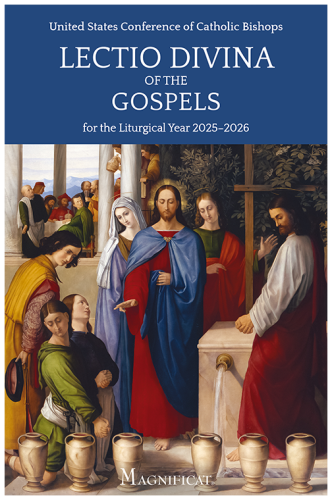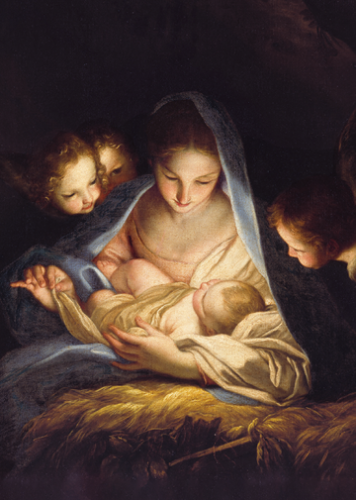The Jonah Sarcophagus (c. 300),
Vatican Museums, Italy.
The enigma of early Christian art
Early Christian art can strike our modern sensibilities as being a bit primitive. The quality is usually not very high, the figures are not in good proportion, and the scenes depicted often seem like a random collection of images with little connection to one another. But perhaps the most surprising thing about early Christian art for us today is the popularity of certain scenes and not of others. The crucifixion, for example, is never depicted in the first three centuries by Christians. Portraits of Christ and the saints are a rarity. Far and away the most popular story is the one depicted here: Jonah and the whale.
The Jonah sarcophagus (a stone coffin) dates from around 300 and is one of the most beautiful examples of early Christian art. Art from underground burial places called catacombs is the most common type of early Christian art that we have; perhaps it is simply what survived. Looking at how Jonah dominates the relief of this sarcophagus we have to ask: why did early Christians depict Jonah so often? And why, in particular, was Jonah in the belly of the whale a fitting scene for funerary art?
The importance of Jonah
In October, the lectionary features the entire book of Jonah, and so it is a good month to reflect on the power of this story and what it might have meant to early Christians. Jonah is actually one of the only Old Testament figures to whom Christ explicitly compares himself, and he even explains the comparison at some length (Jesus is usually much terser!). In Matthew’s Gospel, Christ tells the scribes and Pharisees: An evil and unfaithful generation seeks a sign, but no sign will be given it except the sign of Jonah the prophet. Just as Jonah was in the belly of the whale three days and three nights, so will the Son of Man be in the heart of the earth three days and three nights. At the judgment, the men of Nineveh will arise with this generation and condemn it, because they repented at the preaching of Jonah; and there is something greater than Jonah here (Mt 12:39-41; see also Mt 16:4 and Lk 11:29-32).
Jonah is an unlikely person for Jesus to take as a prophetic figure for himself. Jonah runs away from the call of God, causes misfortune to come upon his companions, and is thrown overboard, where he has some time to think about his decisions in the belly of a great fish. There he prays for deliverance, and goes on to preach to the Ninevites (quite halfheartedly, since he hopes they won’t repent). The story ends with Jonah quarreling with God over a plant that has withered; God uses Jonah’s lament over a mere plant to reprimand him for being so reluctant to convert the Ninevites.
Saint Augustine says that Jonah, despite being basically a bad prophet, is the most sublime because he “prophesied Christ not so much in words as in certain features of his experience. In fact, he prophesied far more clearly in this way than if with his voice he were crying out Christ’s death and resurrection” (City of God 18.30, trans. Babcock). Between Jesus’ own words and Augustine’s we have a strong indication of how Jonah’s story was understood. The very contours of his life were seen as prophetic, rather than his words or even his character. History is conforming itself to Christ’s mystery, even if Jonah does not know it. Just as Jonah was “buried” three days and came up again, so also Christ. The connection with burial is quite explicit in Jonah’s story, where the belly of the whale is likened to Sheol itself (and water generally was associated with the underworld and chaos; see Ez 31:15-16). Jonah emerges a new man and converts a large number of gentiles, foreshadowing Christ’s universal mission.
The sarcophagus as typological
On the sarcophagus itself, there are many hints that Jonah is a type of death and resurrection. First, the entire story boils down to three scenes: Jonah getting cast overboard, Jonah in the depths of the sea, and Jonah reclining on dry land. These three make clear the parallel to the Paschal Mystery. First, Christ dies for others; he is willing to go overboard. Second, Christ is buried, going into underworld—a parallel made clear by the horrible sea monster who evokes the ancient serpent. And lastly, the Resurrection: Jonah rests at peace under the vine of paradise.
Another clue is that only the figures in the Jonah cycle are naked. Nakedness on these early sarcophagi represents new life. Just as babies are born naked, early Christians were also baptized in the nude (and depicted that way). But nakedness is also reminiscent of death—as we come into the world, so we leave it; likewise baptism is both death and new life.
The other scenes on the sarcophagus reinforce this theme of death and resurrection. For example, a tiny Noah floats on the primordial sea into which Jonah is thrown; he is raising his hand to receive the olive branch. Noah was also a common figure in early Christian art—and a favorite image of salvation through water (see 1 Pt 3:20-21). The ark, strikingly, looks like a coffin, and the dove descending on Noah may evoke baptism. On the upper left, we have Jesus calling Lazarus from his tomb, and on the upper right the Good Shepherd calls forth his sheep from death.
The artistic message is clear: just as Christ died and was raised to new life, so also the one buried in this sarcophagus died in hope of salvation through baptism, by which he or she was united to the one greater than Jonah. The one buried here died in hope of the resurrection.
Elizabeth Klein
Assistant professor of theology at the Augustine Institute in Denver, Colorado.
The Jonah Sarcophagus (c. 300), Vatican Museums, Italy. © Eric Vandeville / akg-images.













Additional art commentaries